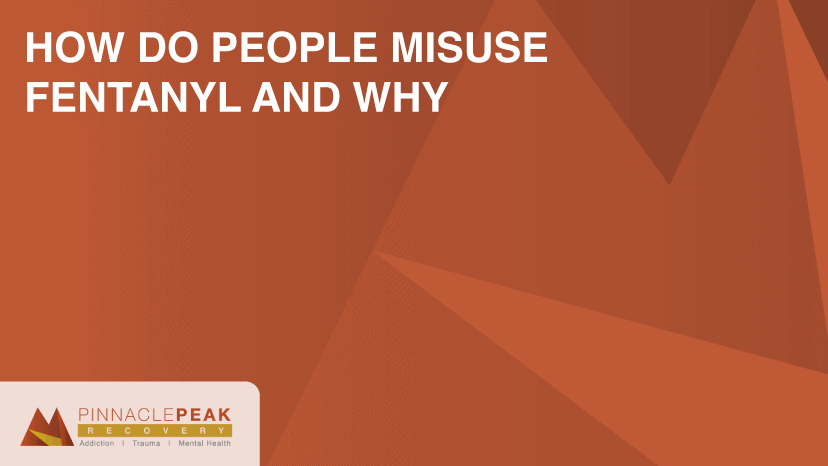You have never been in so much pain in all your life. You’ve tried everything to help with the post-surgical back pain you’re experiencing. Ibuprofen, ice packs, heating pads, aspirin – nothing is working. You’re not sleeping or eating, and your doctor assures you it will pass. But it doesn’t feel like it will ever pass, and you’re not functioning. You need help – and you need it now.
When a friend mentions fentanyl, a highly powerful opioid for aggressive pain management, your interest is peaked. They tell you that ordering it online means a cheap price and speedy delivery, so you make the decision to try it. You go ahead and place the order, thinking the only hassle you’ll endure is the 24-hour wait for delivery. You have no idea that the drug you just ordered was likely produced in somebody’s garage or basement. Or that it has a 60% chance of containing a potentially fatal dose of fentanyl, the most powerful drug in the U.S.
At Pinnacle Peak Recovery in Arizona, we understand the challenges of trying to manage an opioid use disorder (OUD). That’s why we provide compassionate care in a comfortable setting, with an emphasis on evidence-based care in a home-like environment. If you’re managing an OUD, our caring staff can help pave the way for a safer, more comfortable recovery.
In this article, we explain what fentanyl misuse is and what consequences it can have on your health.
How Do People Misuse Fentanyl?
Classified as an opioid drug, pharmaceutical fentanyl can be used safely under the guidance of a doctor. Pharmaceutical fentanyl is used for legitimate reasons such as severe pain management and post-surgical care. It’s also safely used by anesthesiologists for surgical sedation.
However, fentanyl is often intentionally or unintentionally misused. Due to its potency (fentanyl is 100X stronger than morphine), misuse is exceptionally risky.
People misuse fentanyl in one of three ways:
- Taking prescription fentanyl without following the doctor’s instructions. Dosage, storage, and contraindication guidelines are critical to safety.
- Using it in a way not intended by your doctor. Every guideline your doctor lays out for the use of fentanyl is important.
For example, extracting the gel from a fentanyl patch can deliver a higher dosage than what is safe. Combining fentanyl with alcohol increases your risk of respiratory depression. Taking it with contraindicated medications can increase the concentration of plasma or exacerbate respiratory depression. Improper storage can lead to misuse by unsuspecting family members, children, or pets.Any deviance from your doctor’s guidelines on using and storing fentanyl can put you or your loved ones at risk. - Taking medical-grade fentanyl that was not prescribed to you. Or buying your medication from any place other than a legitimate pharmacy. Taking any form of fentanyl not prescribed by your doctor and filled by your pharmacy can put your health at risk.
- Taking IMF (Illegally made fentanyl) for any reason. IMF is inexpensive and easy to produce, making it a popular street drug, but all forms of IMF are dangerous because of its extreme potency. Just two milligrams of fentanyl (about the size of the tip of a pencil) can be enough to cause a fatal overdose.
Because fentanyl is such a powerful opioid, any misuse can lead to serious health consequences.

The Dangers of Fentanyl’s Grip on Arizona
Unfortunately, overdose is a common result of fentanyl misuse and can often be fatal. In the U.S., fentanyl is tied to more fatalities than any other cause of death -- including heart disease and cancer. No corner of the U.S., including Arizona, is free from the current fentanyl crisis.
According to a report by the Arizona Department of Health Services, in 2022, there were 3,423 verified non-fatal opioid-related overdoses in Arizona alone, 64.7% of which involved fentanyl.
“Fentanyl is the single deadliest drug threat our nation has ever encountered.” - DEA Administrator Anne Milgram
Fentanyl misuse can lead to opioid use disorder (OUD), a fentanyl addiction, respiratory depression, or a potentially fatal overdose.
Playing With Fire: Health Hazards of Fentanyl Misuse
Any level of fentanyl misuse, however minor, can cause health consequences. Side effects vary from person to person and are tough to predict. Dosage, frequency of use, body weight, and potency all play a part in how misuse affects a person’s health.
Some of the milder side effects of fentanyl misuse may include:
- Nausea
- Vomiting
- Fatigue
- Moodiness
- Changes in appetite
- A “pins and needles” feeling on your skin
- Hemorrhoids
- Constipation
- Reduced libido
- Menstrual problems
Some of the more serious side effects of fentanyl misuse may include:
- Sepsis
- Seizures
- Inability to process thoughts properly
- Staph infections
- Abscesses
- Damaged opiate receptors in the brain
- Adrenal gland issues
- Muscle stiffness (“fentanyl death pose”)
- Respiratory distress or failure
Because fentanyl is such a potent substance, ignoring your doctor’s instructions or taking fentanyl without medical supervision can immediately put your health at risk. That’s why understanding some of the most overlooked forms of fentanyl misuse is helpful.
Commonly Overlooked Forms of Fentanyl Misuse
When prescribed by a medical professional and used as directed, medical-grade fentanyl can be a valuable pain management tool. However, the potent opioid requires strict adherence to safety precautions.
- Taking fentanyl with other substances or OTC medicines can put you at risk of overdose or other serious side effects. Several substances interact poorly with fentanyl, including (but not limited to) codeine, oxycodone, and buprenorphine.
- Using it without a prescription, even if your reasons for taking it are legitimate. This puts you at high risk of overdose or other health consequences.
- Borrowing a pill from a friend, even if you have a prescription. Never (not even in a pinch!) trust any medication that isn’t prescribed by your doctor and dispensed by a legitimate pharmacy.
- Not disposing of fentanyl properly can cause accidental ingestion by other people or pets. For example, dropping a used fentanyl patch into the trash can may lead to ingestion by small children or pets.
- Ignoring medication guidelines, such as applying fentanyl patches to irritated or broken skin. Or, taking the medication with contraindicated substances can quickly lead to heart distress or overdose.
The above are some ways that people misuse fentanyl without intending to. But there’s another, more common way people unintentionally put themselves at risk. Fake prescription drugs containing fentanyl have recently saturated every corner of the U.S. market, including Arizona. These laced drugs often contain potentially deadly amounts of the potent opioid.
Accidental Ingestion Through Laced Drugs
Unlike most opioids, fentanyl is a synthetic, man-made drug. It’s inexpensive and easy to produce, and its potency makes smuggling and transporting simple. Because it’s so inexpensive, illegal drug dealers often lace fake prescriptions and other drugs with fentanyl to cut costs. To complicate matters, it can be difficult (sometimes impossible) to identify fentanyl by sight or smell.
The Xanax you borrow from a classmate. The Adderall your teenager bought on social media. The Oxy your neighbor pulled out of her purse and offered up when yours ran out. None of these are as safe as they seem.
When you get fentanyl from a source other than your pharmacy, you risk ingesting fake prescription drugs, which can be very dangerous.
- The majority of fake prescription pills on the market today contain potentially fatal doses of fentanyl. According to a 2022 public safety alert from the DEA, 60% of fake prescription pills contain enough fentanyl to potentially cause a fatal overdose.
- Illicit heroin, cocaine, and methamphetamine are frequently mixed with fentanyl, which is nearly impossible to detect.
- Fentanyl-laced marijuana and vape pens tainted with the potent opioid are slowly making their way into the U.S. market. These cases are less common and not yet well-documented. However, they reinforce the need to purchase any drug or medication only from legitimate, legal sources.
Purchasing any drug from an unregulated or illicit source puts you at risk of ingesting a fatal dose of fentanyl.
The Escalating Misuse of Fentanyl Among Arizona’s Younger Population
In Arizona, nearly 10% of opioid deaths in 2022 were attributed to people under the age of 25. Of the 4,622 emergency visits involving suspected opioid overdoses, the same age category accounted for 18.4 % of total visits.
The rising availability of fake prescription medication on social media puts teenagers at exceptionally high risk of accidentally or intentionally ingesting illicit fentanyl.

What Are the Treatment Options for Fentanyl Misuse?
When considering treatment for fentanyl use disorder, you have many options. For example, treatment plans range from short to long-term and inpatient or outpatient, depending on your need or situation. For some people, medication-assisted treatment is the best way to manage withdrawals from fentanyl. Other people may do better with fentanyl treatment that involves only therapy. Often, a combination of both paves the way for long-term recovery.
Whatever your situation, reaching out for help can make the process easier, safer, and more comfortable.
At Pinnacle Peak, we value compassionate care and clinical excellence. Our clients enjoy comfortable surroundings in an environment that is catered to their healing journeys. To take your first steps toward recovery from an opioid use disorder, please call ys at (844) 921-0635.
Discover Warning Signs of Fentanyl Misuse!
Give Us A Call To Today To Learn More About Fentanyl Addiction Treatments!
FAQs
How do people handle fentanyl?
Safe handling of fentanyl requires carefully following your doctor’s and pharmacist's guidelines. These guidelines may include information on how to handle the physical product, contraindications to avoid, and proper storage instructions.
What are the consequences of incorrect use of fentanyl?
Incorrect usage of fentanyl can lead to serious health consequences, overdose, or death.

